Lumbar Spondylolisthesis
Spondylolisthesis is a condition of the spine whereby one of the vertebra slips forward or backward in relation to the next vertebra. Forward slippage of an upper vertebra on a lower vertebra is referred to as anterolisthesis, while backward slippage is referred to as retrolisthesis. Spondylolisthesis can lead to a deformity of the spine as well as a narrowing of the spinal canal (central spinal stenosis) or compression of the exiting nerve roots (foraminal stenosis). Spondylolisthesis is most common in the low back but can also occur in the mid to upper back and neck.
Patients typically have complaints of pain in the back with intermittent pain, numbness and tingling, weakness or muscle spasm to the legs. The diagnosis of spondylolisthesis is easily made using a lateral X-ray (from the side) will show if one of the vertebra has slipped forward compared to the adjacent vertebrae. Often flexion/ extension x-rays are used. Spondylolisthesis is graded according the percentage of slip of the vertebra compared to the neighboring vertebra.
- Grade I is a slip of up to 25%.
- Grade II is between 26%-50%.
- Grade III is between 51%-75%.
- Grade IV is between 76%-100%.
- Grade V, or spondyloptosis, occurs when the vertebra has completely fallen off the next
Treatment will depend on the grade of the “slip” and the symptoms of the patient.
Last modified: October 22, 2019






